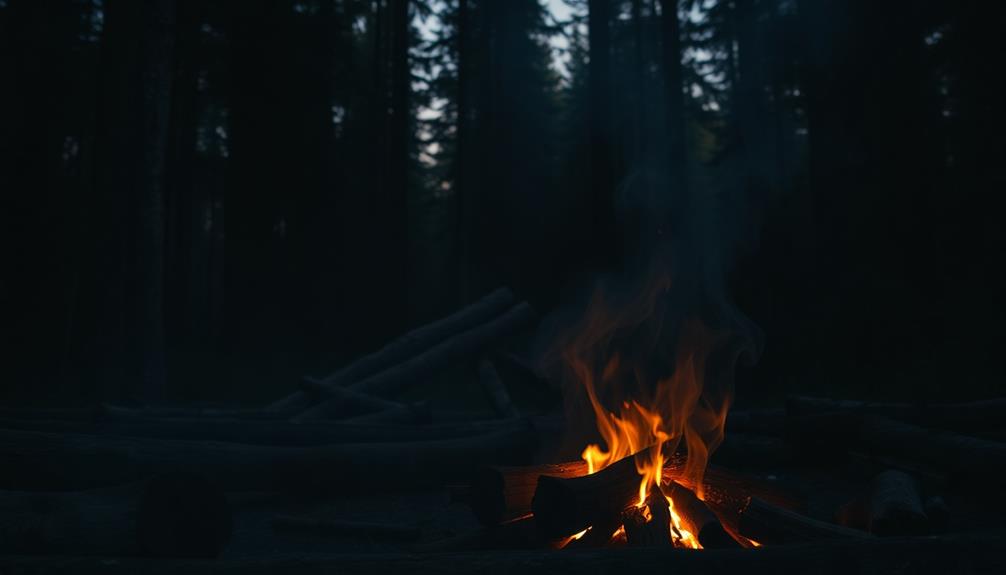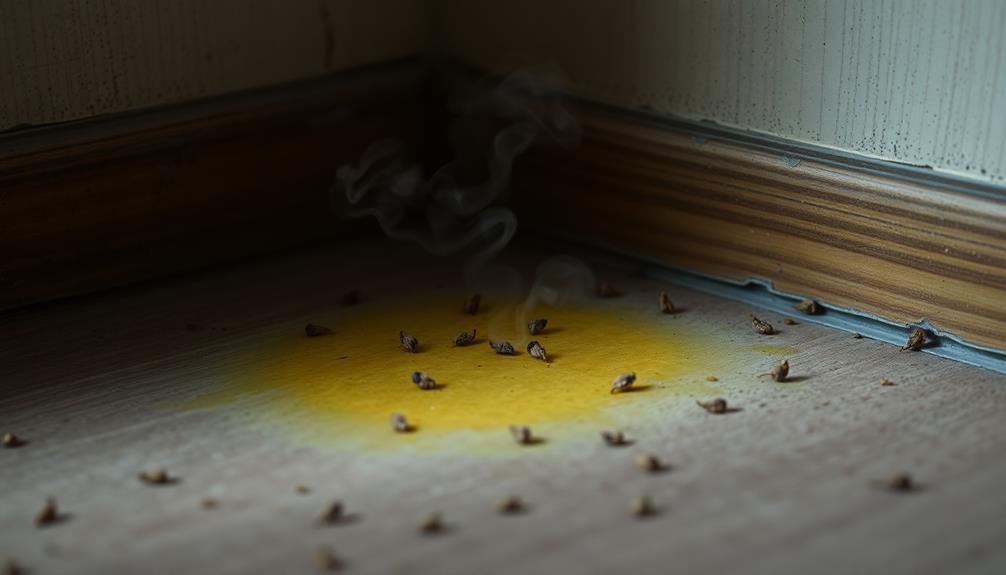Creosote smells strong and unique, often reminding you of burning wood or coal. Sometimes, it even has a hint of mothballs! This odor can become stronger on humid days or if you burn wet wood. When creosote builds up, it can become musty, creating a more intense smell. You might notice this scent in homes with fireplaces or wood stoves, especially during colder months. While it can bring back cozy memories of campfires, it's important to remember that creosote can be harmful too. There's so much more to learn about this fascinating topic!
Key Takeaways
- Creosote has a pungent odor resembling burning wood or coal, with a chemical quality similar to mothballs.
- The smell intensifies in humid conditions and can lead to musty scents if not addressed.
- It results from incomplete combustion of organic materials, containing phenols and aromatic hydrocarbons.
- Stronger scents are often detected near chimneys or structures made from creosote-treated materials.
- Exposure to creosote fumes can cause respiratory irritation and long-term health risks, emphasizing the need for chimney maintenance.
Introduction

When you light a fire in your fireplace or wood stove, you might notice a distinct smell that lingers in the air—this is creosote. The creosote smell can be pretty strong, almost like burning wood or coal, and sometimes even a bit like plastic. That's because creosote contains some tricky compounds that can create those pungent odors.
You might be surprised to learn that this smell can change due to the weather, like humidity and temperature. Your burning habits also play a big role! If you're using seasoned wood and keeping your fire burning hot, you'll likely have less creosote in the chimney.
However, if you ignore the creosote smell, it can build up and lead to some serious issues. That's why regular chimney maintenance is essential. It helps keep your chimney clear and safe.
Plus, you won't have to deal with those musty odors that come from accumulated creosote, which can remind you of mothballs. So, next time you enjoy a cozy fire, pay attention to that smell. It's an important sign that can help keep your home safe and your fires enjoyable!
Description of the Smell
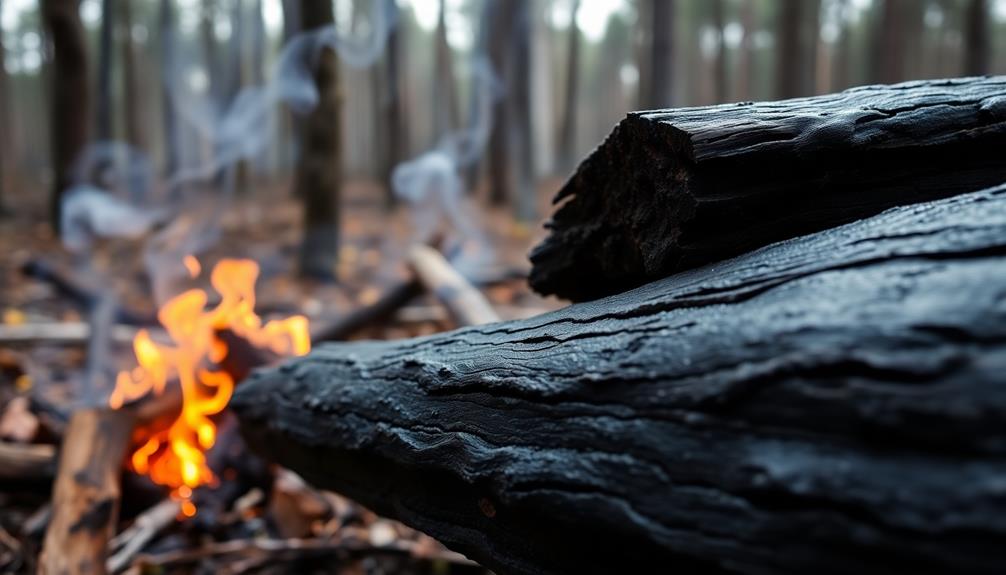
With its unmistakable pungent odor, creosote often resembles the smell of burning wood or coal, creating a strong presence in the air. When you catch a whiff of creosote, you might notice that it's not just a single smell. There's a slightly chemical or acrid quality that can remind you of mothballs. This unique odor comes from the compounds in creosote, like pyridine.
If there's a buildup of creosote in your chimney, the smell can change, too. It might take on a musty scent, especially if moisture is present. This combination can make the odor even more pronounced. When you burn wood and don't fully combust it, that can lead to more creosote forming and intensifying the smell.
The intensity of this creosote odor can also change depending on the weather. For example, on humid days, the scent might feel stronger and stick around longer.
Source and Composition
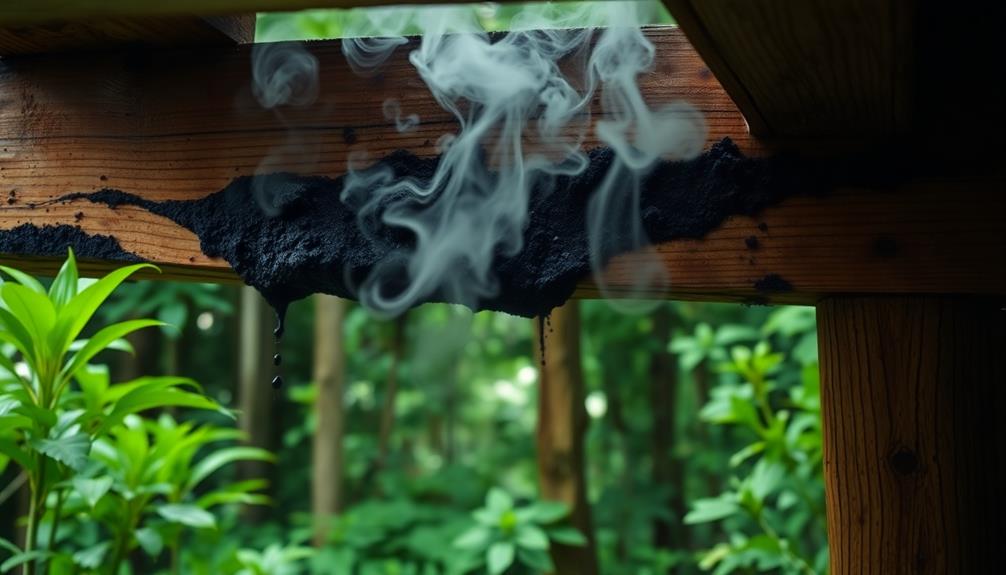
Creosote forms as a byproduct of incomplete combustion, primarily from burning organic materials like wood and coal. When you light a fire, the combustion process doesn't always burn everything completely. This can create a sticky, tar-like substance known as creosote. It's fascinating how this process can lead to strong odors!
The chemical makeup of creosote includes phenols and aromatic hydrocarbons. These compounds are what give creosote its pungent smell, often likened to burning wood or coal. You might even notice a scent similar to mothballs, which comes from pyridine, another organic compound found in both creosote and mothballs.
The smell of creosote can change based on several factors. For instance, the type of wood you burn and the conditions during combustion can make the aroma stronger or weaker. If there's a chimney fire, the buildup of creosote can produce an even more intense odor.
It's important to remember that creosote can also carry a slightly acrid or chemical scent, hinting at toxic compounds.
Typical Scenarios or Environments
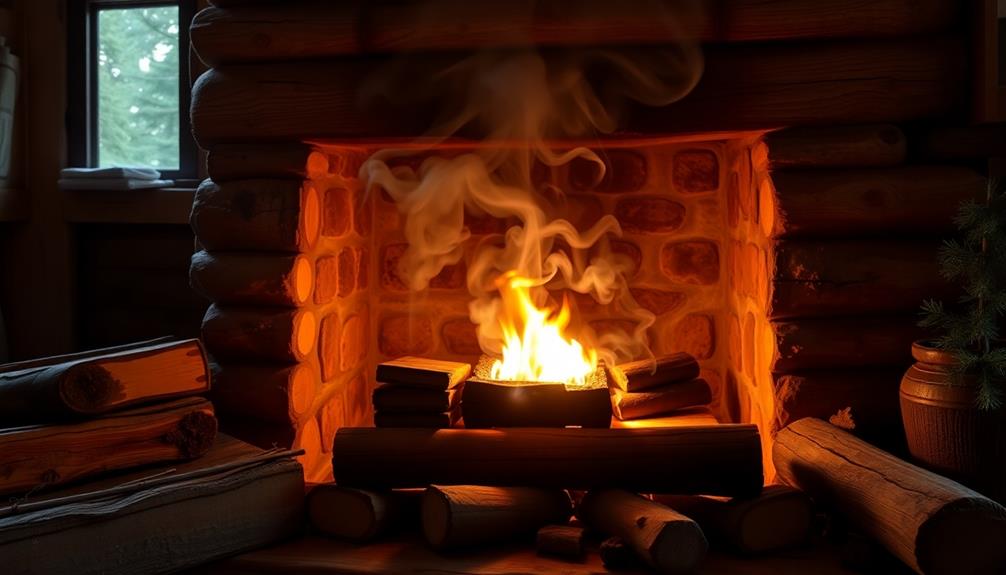
In homes equipped with fireplaces or wood-burning stoves, the pungent smell of creosote often fills the air, especially during colder months. You might notice this strong odor when there's poor burning, which happens if you use wet wood or if the airflow is blocked.
When creosote fumes gather in the chimney flue, it creates an unmistakable tar-like scent that can be quite overwhelming.
Outside, the scent can be even stronger near structures made from creosote-treated materials, like railroad ties or utility poles. On a warm, humid day, you'll find that the smell can seem to hang in the air, making it more noticeable. This distinct aroma can often carry hints of tar and earthiness, blending with the environment in a unique way. Interestingly, some people may even detect subtle nuances that resemble heliotrope fragrance characteristics, which are known for their sweet, almond-like scent. These unexpected notes can add an intriguing complexity to the overall smell, making it all the more memorable.
It can remind you of mothballs, thanks to similar chemical compounds present in both.
Whether you're cozying up by a wood stove or walking near a treated wood fence, the smell of creosote is hard to miss.
It's a unique aroma that ties into many environments. So, next time you catch a whiff, you'll know just what it's and where it might be coming from!
Emotional or Cultural Associations
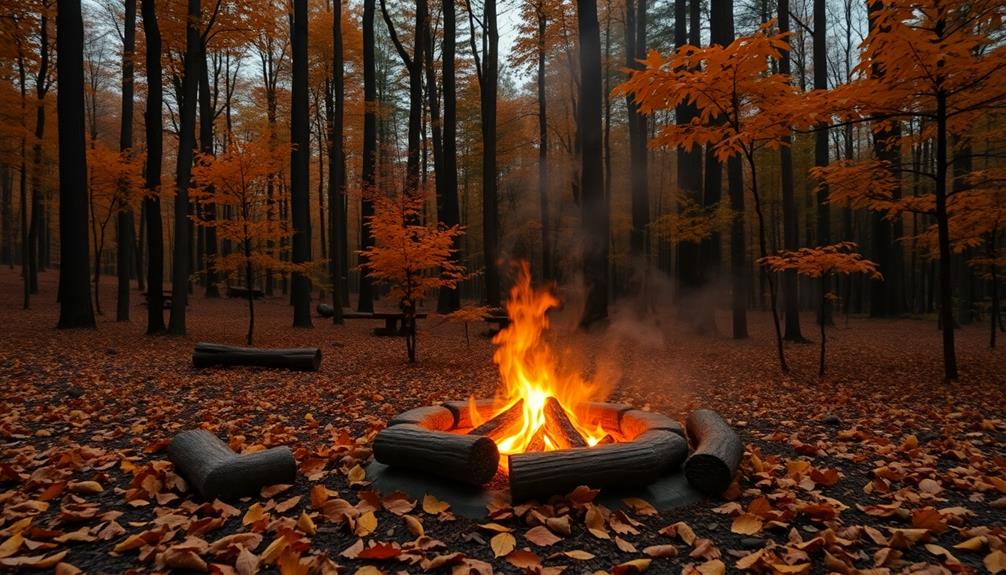
How does the smell of creosote resonate with your experiences? When you catch a whiff of that strong, smoky scent, it might remind you of cozy campfires and fun outdoor gatherings. That warm feeling of connection to nature often brings back happy memories.
In some cultures, the smell of creosote is tied to traditional wood-burning stoves, symbolizing comfort and home.
But there's a twist! While the smell can evoke joyful feelings, it can also stir some unease. You might think about the health risks linked to creosote, especially if you've had to deal with chimney maintenance before. That's an important task because creosote can build up and lead to fire hazards.
Additionally, many people link the scent to industrial history, particularly in places where treated wood was used in construction. This connection fosters a sense of cultural identity.
Health or Safety Considerations
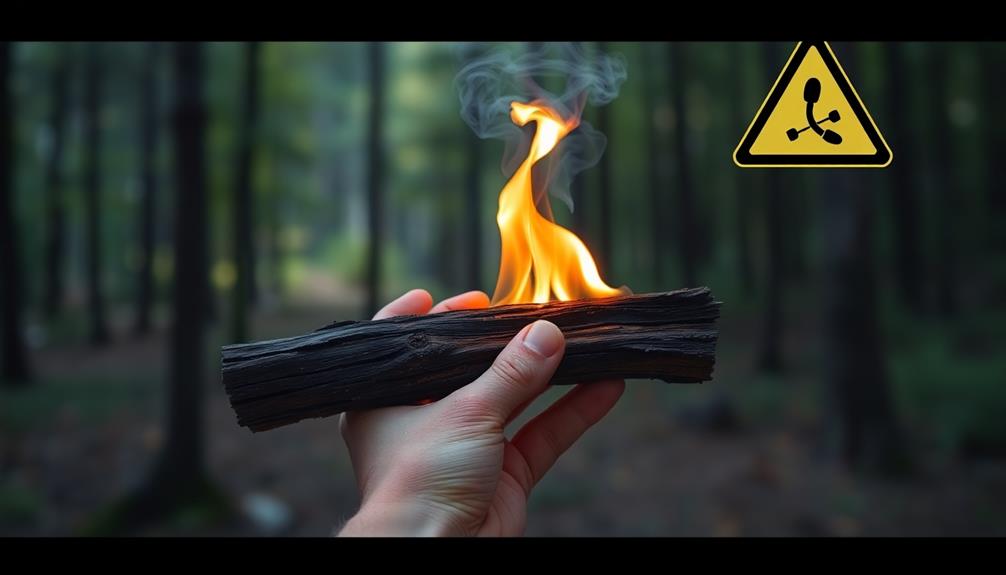
The strong, smoky scent of creosote may evoke fond memories for some, but it's crucial to recognize the serious health risks associated with it. Exposure to creosote fumes can irritate your eyes, nose, and throat. You mightn't notice it right away, but long-term exposure is linked to respiratory issues and even an increased risk of cancer. The IARC and EPA have classified creosote as a dangerous substance, so it's essential to take precautions.
If you accidentally ingest creosote, it can cause severe stomach pain and a burning sensation in your mouth and throat. Yikes! Skin contact can also be a problem, leading to rashes and irritation. That's why wearing protective clothing is super important when handling treated materials.
Children are especially vulnerable. They often don't wash their hands as well as adults, which increases the risk of unintentional exposure.
To ensure the safety of your home, make sure to keep creosote away from little hands and be mindful of where it's used. Staying informed about these health risks will help you enjoy those memories safely!
Final Thoughts
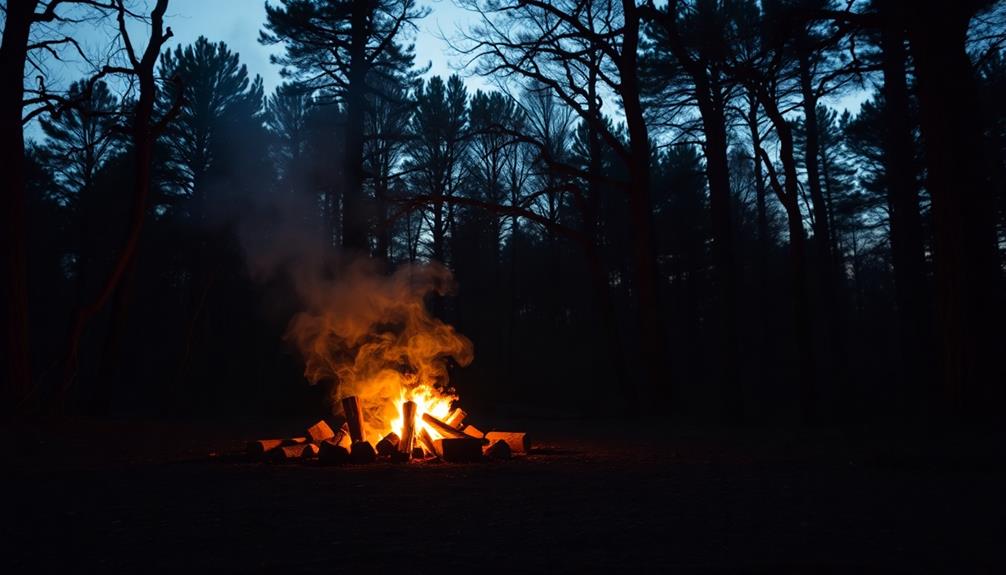
Why should you care about the smell of creosote? Well, understanding this pungent odor can help keep your home safe and comfortable. Creosote often smells like burning wood or coal, and it can be quite strong! If you notice a burning sensation in your nose or throat when you smell it, that's a sign that something might be wrong.
Incomplete combustion, especially when burning unseasoned or wet wood, can make the smell even worse. This isn't just about an unpleasant scent; creosote buildup can lead to serious fire hazards. That's why having a professional chimney cleaned every year is so important. Regular maintenance helps manage creosote and keeps the smell at bay.
Some people even compare creosote's scent to mothballs, which can be surprising! But knowing what you're dealing with can help you take action.
Frequently Asked Questions
Can You Smell Creosote?
Yes, you can smell creosote, especially in areas where wood's burned. If you notice a strong, acrid odor, it might be time to check for buildup in your chimney. Don't ignore those warning signs!
Is Creosote Smell Harmful to Humans?
Yes, creosote smell can be harmful to you. Inhaling its fumes may irritate your respiratory system and pose long-term health risks, especially with repeated exposure. It's crucial to ensure proper ventilation and chimney maintenance.
What Does Creosote Smell Like When It Rains?
When it rains, you'll notice creosote's smell intensifies, becoming more pungent and reminiscent of burning wood. The moisture activates its compounds, making the odor sharper and more pronounced, especially in poorly ventilated areas.
Is Creosote Harmful to Breathe?
Yes, creosote's harmful to breathe. You can experience irritation in your eyes, nose, and throat, plus long-term exposure may lead to serious respiratory issues. It's crucial to minimize inhalation to protect your health.
